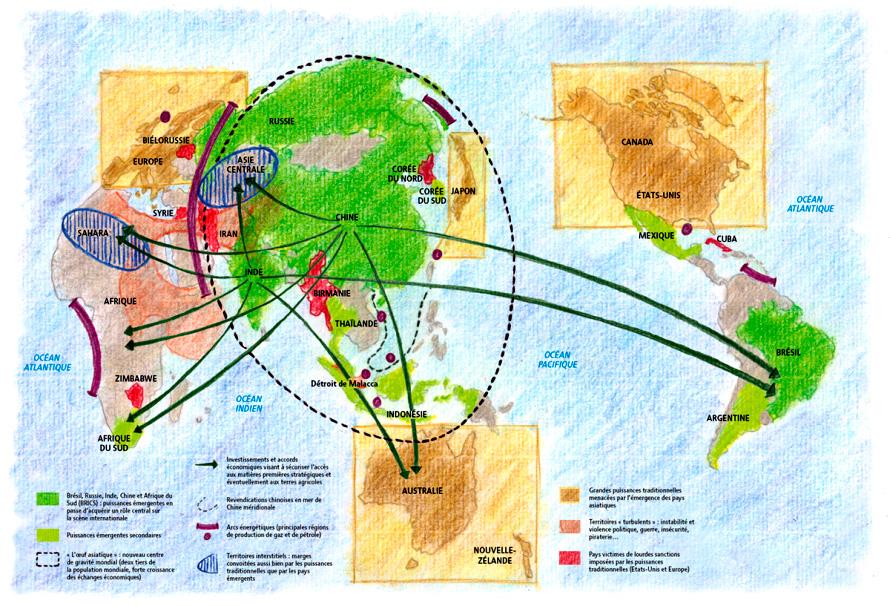Old Terms and New Worlds: Challenges for Global Studies in the 21st Century
archive


Leaders at the 196 meeting in Belgrade, Yugoslavia, that formally established the Non-Aligned Movement.
Old Terms and New Worlds: Challenges for Global Studies in the 21st Century
The bipolar world of the Cold War era was subdivided by three levels or blocs: the First World (the west), the Second World (the socialist countries), and the Third World. Its essential features were determined by the economic and political arrangements of the countries that made up the international system. The term ‘Third World’ referred to countries in Africa, Asia, and Latin America, and as such represented the vast majority of the states of the world.
During this era, especially after the large decolonialization processes in Africa and Asia in the 1960s, the term Third World had a positive connotation, relating to the Tiers État of the French revolution. Alfred Sauvy (1952), a French demographer, coined the term. Many of the former colonies wanted to stress their specific position in the economic world system, as well as their political intent not to be dependent on either of the two superpowers, the USA and the Soviet Union, by embracing the term Third World. In forming the Non-Aligned Movement, as was clearly anticipated at the Bandung conference in 1955, a large number of participating countries made a joint political statement declaring an independent neutral position in the midst of the Cold War.
Scholarship was also influenced by this process of realpolitik on a global scale, with the Third World becoming recognized as an independent entity for research and teaching. Numerous new professorships focusing on development research were established at different universities worldwide. Simultaneously, books featuring the term Third World in their titles were published and became basic literature for generations of students.1 Several journals focusing on development research appeared, and although some of these journals changed their names and relinquished the term, the Third World Quarterly retains it to the present day.
Thus, researchers as well as politicians used the terms First, Second, and Third World to describe and categorize the global economic and political system of the 1950s through 1980s. But the year 1989 fundamentally changed this architecture, marking the advent of a post-Cold War global order. After 1989, the Second World disappeared as an ideological bloc, but continued to exist as a ‘developing’ world sui generis.
Criticism has been raised for some time about the term Third World.2 Ulrich Menzel (1992), pondered the end of the Third World and bid “farewell to a false term.” Indeed, one can argue that there has never been a homogenous Third World with common interests, but rather a diffuse solidarity against the hegemonic west. The present essay, rather than taking a strong position on this debate, simply uses it to highlight the importance for Global Studies of adequate terminology in researching and characterizing the contemporary world we live in.
In the decade before the millennium, discussions about globalization began to introduce a “One World” terminology. By the 1990s, more people were thinking globally: more problems were recognized as intrinsically global, more civil society organizations were spreading globally, more institutions operated globally. In that process, environmentalism, human rights, feminism, and other movements as global forces unsettled old ways of doing things, helping to crystallize a global semantic field in which individuals and states were related to both the system of nation-states and to a broader sense of humankind itself. These globalization debates in academia also influenced the commercial sector. To take a mundane example, shops selling products from so-called Third World countries changed their names from ‘Third World’ shops to ‘World’ shops. ‘Global’ began to be perceived as an independent entity for research and teaching, giving rise to the new academic field of Global Studies.
Many of the former colonies wanted to stress their specific position in the economic world system, as well as their political intent not to be dependent on either of the two superpowers... by embracing the term Third World.
After the millennium, global threats like transnational terrorism and climate change inspired global commonalities, but in recent years we’ve also witnessed the emerging contours and now the rapid proliferation of a resurgent nationalism. As one observer described it, “Nationalism is globalizing.”3 In the post-millennium era, other major socio-economic and political power shifts have been taking place across the world: “club governance” in the form of BRICS or the G20 entered the political stage, while the economic and political rise of China has changed the balance of power on a global scale. With China’s ascendence as a new superpower, Le Monde Diplomatique (2012) published a world map in which North America, Australia/New Zealand, Europe and Japan are categorized as “Old Empires.”

Mondes émergents. (Source: Le Monde Diplomatique 2012).
The map depicts the BRIC-states of Brazil, Russia, India, and China as the powers of tomorrow with the Asian egg in the center of the drawing, representing two third of the world’s population and a dramatically growing share of world trade. But while the map captures something of these enormous power shifts, the terms that researchers use to categorize the world still often reflect the past.
Thus it can be argued that one of the biggest challenges for Global Studies in the 21st century has to do with the problem of “old terms” in relation to “new Worlds.” Researchers need to reflect on the extent to which Global Studies discourses and terminology fully address and comprehend present dynamics, inquiring seriously into the appropriate terms for analyzing the unequal developments of world regions. Global Studies has at its disposal a wide variety of terms for categorizing the phenomena it researches. For example, whereas the United Nations stresses social indicators for structuring the world with its Human Development Index, the World Bank mainly focuses on economic aspects with its World Development indicators. These indices obviousy portray different views of the world. There is also an ongoing discussion about giving up the terms ‘Developed’ and ‘Developing’ World, with some arguing that they are derogatory and hierarchical. Meanwhile, scholarly literature and everyday language still reflect the “old” terms; Global Studies students are confronted with them in textbooks, the media, and in common useage.
The graphic below is one way of summarizing the power shifts that have been taking place on a global scale. It depicts both old and new terms, as well as old and new worlds, as upward movers and downward movers.

Old terms and new worlds. (Source: Nuscheler/Wittmann 2019)
For some time the terms Global South and Global North have been replacing the old First, Second, Third, and Fourth Worlds in academic discussion. One should then debate whether the new terms are adequate to analyze the world we live in. To give just a brief example of such debate, the editor of the journal The Global South, Leigh Anne Duck (2019), favors the newer term over the old Third World and Developing World, opining that it is better suited to resisting hegemonic forces that endanger the autonomy and development of states. A counter-position is articulated by Boike Rehbein (2019), who argues that the people choosing the new term ‘Global South’ are mainly members of the upper classes in those states.
Researchers need to reflect on the extent to which Global Studies discourses and terminology fully address and comprehend present dynamics, inquiring seriously into the appropriate terms for analyzing the unequal developments of world regions.
The impulse to use new terminology emphasizes not only the uneasy reality of olds terms like Third World but also implies a mindfulness of the political connotations that accompany old and new terms alike. ‘Third World’ and ‘the Global South’ can be interpreted many ways and used to support different kinds of political, historical, and cultural arguments. I would point out here that by giving up the old term Third World, one also abandons the positive political connotations which were clearly visible when newly independent states used this term in the 1960s. The new titles Global South and Global North are vague “umbrella” terms that do not come close to reflecting the heterogeneity of the worlds they are meant to signify; indeed, it has been argued that there is a Global South and Global North within each of these two mega-regions. While all these terms, whether the old or the new, are just attributions, a virtue of First, Second, and Third World is that there are more common features among the countries designated by these labels.
To summarize, in academic discourse researchers depend on terms to structure and categorize reality, which is essential for comprehending the world. Consequently, it is very important in the settings of contemporary research and teaching that Global Studies scholars discuss and debate adequacy of terms for the categorizing and understanding of the world in the 21st century.
1. For e.g., Handbuch der Dritten Welt, by Dieter Nohlen and Franz Nuscheler (1993) in German-speaking regions of the world.
2. Brian C. Smith (2003) gives an overview on the ‘idea of a Third World’.
3. Colin Crouch, 2017.
Crouch, Colin in Zeit Online: https://www.zeit.de/wirtschaft/2017-02/globalisierung-widerstand-rechte-... (11.02.2017)
Duck, Leigh Anne (2019): https://web.archive.org/web/20160904205139/http://gssc.uni-koeln.de/node... (12.07.2019).
Le Monde Diplomatique 2012: https://blog.mondediplo.net/2013-12-22-Cartes-en-colere (06.09.2019).
Menzel, Ulrich 1992: Das Ende der Dritten Welt und das Scheitern der großen Theorie. Suhrkamp Verlag.
Nohlen, Dieter/Nuscheler, Franz 1993: Handbuch der Dritten Welt. 8 volumes, Dietz JHW.
Nuscheler, Franz/Wittmann, Veronika 2019: 'Old terms and new worlds'. Authors’ own graphic.
Rehbein, Boike 2019: https://web.archive.org/web/20160904205139/http://gssc.uni-koeln.de/node... (12.07.2019).
Sauvy, Alfred 1952: Trois mondes, une planète, L’Observateur, 14.08.1952.
Smith, Brian, C. 2003: Understanding Third World Politics, Theories of Political Change & Development. Second edition. Indiana University Press.
The Global South 2019: http://www.iupress.indiana.edu/pages.php?pID=79 (12.07.2019).
Third World Quarterly 2019: https://www.tandfonline.com/toc/ctwq20/current (12.07.2019).



